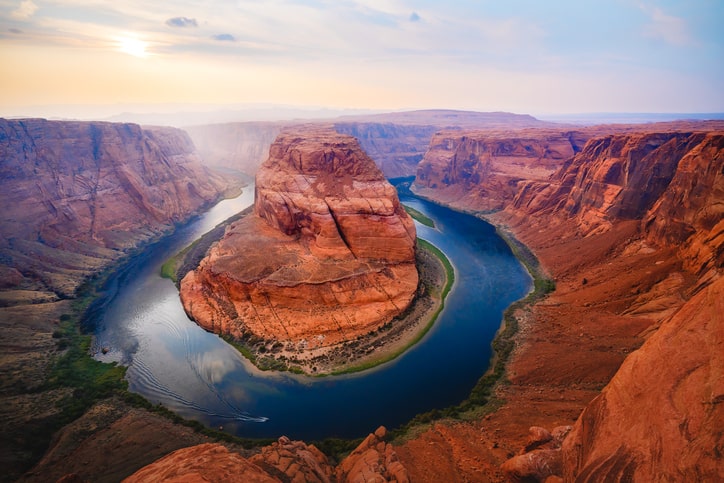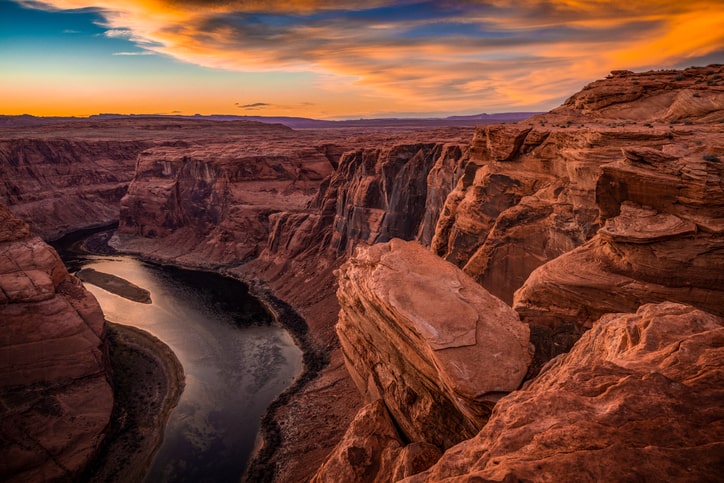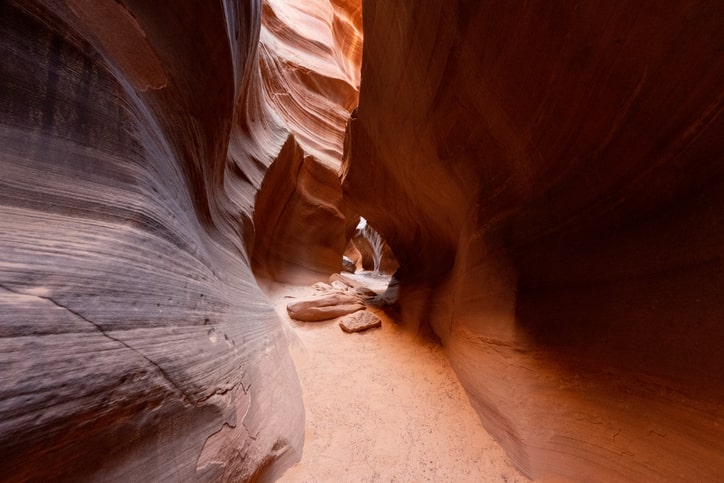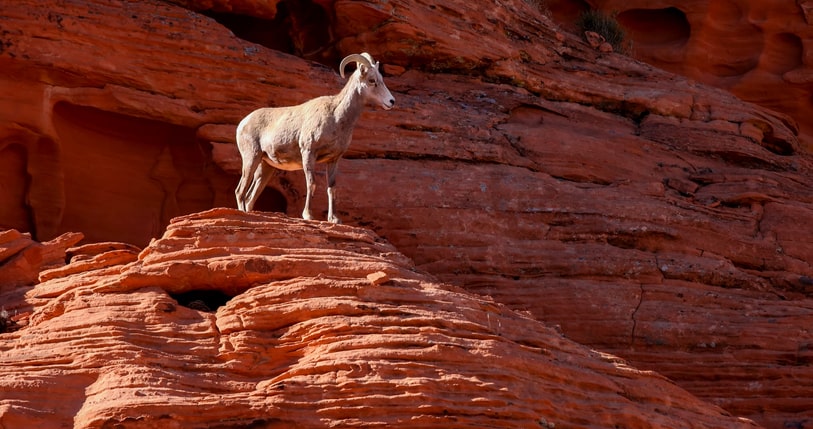The Grand Canyon: Facts, History & Profile


Fast Grand Canyon Facts
Length: 277 miles (446 km)
Width: 18 miles (29 km) at widest point
Depth: 1 mile (1.6 km) deep
Age: Estimated to be between 5-6 million years old
Main location: Arizona, United States
Grand Canyon Trivia
- The canyon is home to over 70 species of mammals, 250 species of birds, and 25 types of reptiles.
- The canyon is considered one of the Seven Natural Wonders of the World.
- The canyon is visited by over 5 million people each year.
- The canyon is not the deepest canyon in the world. That title belongs to the Yarlung Tsangpo Grand Canyon in Tibet, which is over 17,000 feet deep.
- The canyon is a sacred site for many Native American tribes, who have lived in the area for thousands of years.

As one of the world's most awe-inspiring natural wonders, the Grand Canyon draws visitors from all over the globe to marvel at its towering cliffs and vivid colors. Carved over millions of years by the mighty Colorado River, this UNESCO World Heritage Site spans over 270 miles and reaches depths of over a mile deep in some areas.
Scientists from around the world come to study the geology, biology, and ecology of the region. The canyon's unique landscape and diverse ecosystem make it an ideal location for research on climate change, wildlife, and even the origins of life on Earth.
But it's not just the sheer size that makes the Grand Canyon so special. Each layer of rock tells a different story, showcasing the geological history of our planet. And if the views alone aren't enough to take your breath away, the Canyon is also home to a diverse array of wildlife, from big horn sheep to mountain lions.
In this profile, we will take a closer look at the Grand Canyon and explore some of its fascinating features — so, if you are a Grand Canyon visitor or simply interested in this incredible landmark, keep on reading for more information!
The History of the Grand Canyon
The history of the Grand Canyon dates back to prehistoric times, as the ancient Puebloan people were known to have lived in the area around 12,000 years ago. They left behind numerous artifacts, including pottery, tools, and structures, providing us with a glimpse into their daily lives. However, the Grand Canyon as we know it today was first discovered by European explorers in the 16th century.
The first recorded discovery of the Grand Canyon was made by García López de Cárdenas, a Spanish conquistador, in 1540. Cárdenas was searching for the fabled Seven Cities of Gold when he and his men came across the Grand Canyon. They were the first Europeans to lay eyes on the canyon, and Cárdenas named it "El Gran Cañón" (the Great Canyon).
Despite Cárdenas' discovery, the Grand Canyon remained largely unexplored for centuries. It was not until the mid-19th century that the Grand Canyon was fully explored and mapped. In 1857, Lieutenant Joseph Christmas Ives led an expedition down the Colorado River in an attempt to chart a navigable route for steamships. Ives and his team encountered many challenges along the way, including dangerous rapids and hostile Native American tribes. Despite these obstacles, Ives was able to make detailed maps of the canyon and its surroundings.
John Wesley Powell, a geologist and explorer, led the first successful expedition down the Colorado River through the Grand Canyon in 1869. Powell and his team faced many challenges on their journey, including treacherous rapids, dangerous waterfalls, and hostile Native American tribes. Despite these obstacles, Powell was able to complete the journey and make detailed maps of the canyon and its surroundings.
Powell's expedition was a major milestone in the exploration of the Grand Canyon. It opened up the canyon to further exploration and study, and it helped to establish the Grand Canyon as a significant geological formation. Since then, the Grand Canyon has become a popular destination for tourists and adventurers from around the world, and it continues to be a source of scientific and cultural fascination.
In 1919, the Grand Canyon was established as a national park, and it has since become one of the most visited parks in the country. The park is home to numerous species of wildlife, including the endangered California condor, and it remains an important site for ongoing geological research and discovery.
Native American Culture
The Grand Canyon is not only an awe-inspiring sight but also a cultural hub. It is home to several Native American tribes, including the Havasupai and Hualapai tribes, who have inhabited the area for centuries. These tribes have a rich cultural heritage that visitors can learn about through guided tours and cultural exhibits. The Havasupai and Hualapai tribes have distinct cultures, which visitors can explore and appreciate. They have created a rich cultural heritage in the region, with their own unique traditions, music, and art.
In addition to learning about Native American culture and history, visitors to the Grand Canyon can also immerse themselves in the natural beauty of the area. The Grand Canyon West, located on Hualapai land, is a must-see destination that offers a unique and immersive experience. The Skywalk, a glass bridge that extends over the canyon, provides a breathtaking view that is not for the faint of heart. Visitors can also take a helicopter tour of the Grand Canyon and see the beauty of the area from above.

Formation of the Grand Canyon
The Grand Canyon is a result of millions of years of geological processes. It is believed that the Colorado River slowly eroded the rock over a period of around six million years, creating the deep and steep canyon we know today. The layers of rock that are visible in the canyon walls provide a fascinating glimpse into the Earth's geologic history. Some of the rocks date back over two billion years, which is a testament to the power of time and nature.
The formation of the Grand Canyon was a complex process that involved many factors. The Colorado River played a significant role in shaping the canyon, but it was not the only factor. The rocks that make up the canyon were also affected by tectonic activity, which caused the rocks to uplift and tilt. These movements, combined with the erosive power of the river, led to the creation of the Grand Canyon as we know it today.
The canyon is not just a result of erosion, but also of deposition. As the river eroded the rock, it also deposited sediment along the riverbed and on the canyon floor. This sedimentation process helped to create the unique features of the canyon, including the colorful rock formations and the steep cliffs that are visible from the rim.
Overall, the formation of the Grand Canyon is a testament to the power of nature and the processes that shape our planet. It is a fascinating example of how geological and environmental factors can work together to create a natural wonder that is both beautiful and awe-inspiring. Visitors to the Grand Canyon can experience this wonder for themselves and learn more about the geologic history of the Earth in the process.
The Grand Canyon's Size and Features
The Grand Canyon is approximately 277 miles long, up to 18 miles wide, and over a mile deep, making it one of the largest canyons in the world. It is divided into two sections: the Grand Canyon South Rim and the North Rim. The South Rim, which includes Tusayan, is the most popular and accessible area, while the North Rim is more remote and less visited, but equally beautiful with its own unique features.
The Grand Canyon also boasts a variety of unique rock formations, including the Vishnu Basement Rocks, the Coconino Sandstone, and the Kaibab Limestone, which can be explored through guided tours. Kolb and Yavapai are two popular viewpoints on the South Rim, while the North Rim offers breathtaking views from Point Imperial and Cape Royal.
Activities at the Grand Canyon
The Grand Canyon offers a wide range of activities to visitors, making it possible to experience the canyon in numerous ways. In addition to the popular activities listed below, visitors can also choose to hike, take a mule ride, or even go on a helicopter tour for a unique perspective of the canyon.
- Hiking: The most popular hiking trail is the Bright Angel Trail, which descends into the canyon and offers stunning views of the rock formations. Other trails include the North Kaibab Trail and the South Kaibab Trail, with varying levels of difficulty. Visitors can also take guided hiking tours.
- Rafting: Visitors can take a whitewater rafting trip down the Colorado River, which allows for a more immersive experience. The river flows through the heart of the canyon, offering breathtaking views of the surrounding landscape. Canyon tours are also available.
- Scenic drives: There are numerous scenic drives along the rim of the Grand Canyon, including Desert View Drive and Hermit Road, which offer stunning vistas and viewpoints of the canyon. Shuttle bus services are available at the park. The most popular is the 23-mile-long Desert View Drive, which offers numerous lookout points and vistas of the canyon.
- Skywalk: Located on the Hualapai Indian Reservation, the Grand Canyon Skywalk is a glass bridge that extends 70 feet out into the canyon. Visitors can walk out onto the bridge for a unique perspective of the canyon.
- Helicopter tours: For a bird's eye view of the canyon, visitors can take a helicopter tour, which provides a unique and unforgettable perspective of the canyon's size and features.
- Visitor centers: There are numerous visitor centers along the rim, including the Grand Canyon Village and the Desert View Visitor Center. These centers offer exhibits and information about the canyon's geologic history and cultural significance.
- Camping: There are several campsites located within the park, including the popular Phantom Ranch and the Mather Campground. Visitors can also stay at an RV park or book a room at one of the lodges within the park. El Tovar is a historic lodge on the South Rim that offers a luxurious Grand Canyon vacation experience.
These are just a few of the many ways to experience the Grand Canyon. With so much to see and do, it's no wonder the canyon is a must-see destination for travelers.
The Grand Canyon: Nearby Attractions
There are numerous attractions in the vicinity that visitors can explore while in the area. Some of these include:
- Horseshoe Bend: Located in Page, Arizona, Horseshoe Bend is a beautiful natural formation in the Colorado River, offering a unique and picturesque view of the river and surrounding landscape.
- Antelope Canyon: Also found near Page, Arizona, Antelope Canyon is a fascinating slot canyon that can be explored through guided tours. The canyon is known for its unique rock formations and beautiful colors.
- Williams: A historic town located on State Route 66, Williams offers a glimpse into the past with its classic diners, gift shops, and vintage motels. Visitors can also take the Grand Canyon Railway from Williams to the Grand Canyon South Rim.
- Flagstaff: A vibrant college town located near the Grand Canyon, Flagstaff offers a variety of outdoor activities, including hiking, skiing, and mountain biking. Visitors can also explore the Lowell Observatory and the Museum of Northern Arizona. Phoenix and Las Vegas are also popular starting points for a Grand Canyon vacation.
Plan Your Visit to the Grand Canyon
To plan your visit to the Grand Canyon, visit the National Park Service website at nps.gov. The park offers several lodging options, including lodges, cabins, and campsites. Visitors can also book guided tours and activities through the park's website or at the various trailheads and visitor centers. Buttes, located in the southwestern part of the park, is a popular area for backcountry camping and hiking.
The Grand Canyon is not just a natural wonder, but a vast and diverse landscape that offers visitors of all ages and interests a chance to experience and explore the Earth's geologic history and cultural significance. Whether you're a seasoned hiker, a nature lover, or simply looking for a unique and awe-inspiring experience, the Grand Canyon has something for everyone.
Concluding the Canyon
The Grand Canyon is an awe-inspiring destination that offers a unique and unforgettable experience. Whether you're exploring the canyon's geologic history, immersing yourself in Native American culture, or simply taking in the breathtaking views, the Grand Canyon is a must-see destination that will leave you feeling inspired and rejuvenated. So start planning your visit today and discover the wonder and beauty of this natural treasure for yourself!
Do you want to test your newfound knowledge? Try out our Grand Canyon Quiz!
People Also Ask...
Other travelers and curious searchers have similar questions about the Grand Canyon, which we have answered below.
How Was the Grand Canyon Formed?
The Grand Canyon was formed by the erosive action of rushing waters from the Colorado River over millions of years. The river and tributary creeks carved their way through layers of sedimentary rock, exposing different geologic strata in a stunning display that gives us a snapshot of Earth's past.
What Is the Grand Canyon Famous For?
The Grand Canyon is a world-renowned destination and one of the most spectacular natural wonders in the United States. It's famous for its stunning beauty, awe-inspiring geology, rugged geography, and a vast array of wildlife. The canyon stretches 277 miles long, up to 18 miles wide, and reaches a depth of 6,000 feet — truly an amazing sight to behold!
What 4 States Is the Grand Canyon In?
The Grand Canyon is located in the Southwestern United States, spanning across four states - Arizona, Nevada, Utah, and Colorado. The majority of the canyon lies within Arizona and it encompasses parts of Coconino County, Mohave County, and Coconino National Forest. In addition to these three counties, a small portion of the canyon lies within Kane County in Utah.
Can You See the Grand Canyon From Space?
Yes, the Grand Canyon is visible from low levels of space, although it can be difficult to see due to its color blending in with the surrounding landscape, making it an even more unique natural wonder. Low satellites are able to make out its outlines due to differences in terrain and vegetation.
What Is the Best Time of Year to Visit the Grand Canyon?
The best time to visit the Grand Canyon is in the spring or fall, when the weather is mild and the crowds are smaller, allowing for a more immersive experience.

About the author







